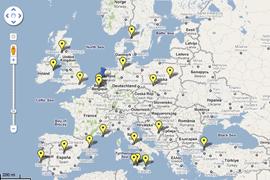Creative industries add a youthful, vibrant, cutting edge to London’s more regal historical image. Because when it comes to London, it is truly a mix of old and new. The area that benefits most of these industries is East End, a part of London associated with poverty, overcrowding and immigrants. The arrival of creative businesses made a significant change in atmosphere of the area.
The best example of this change is Brick Lane, a centerpoint of London’s East End. Start walking towards the south part of the street, and you will encounter many curry houses. It’s no wonder some consider it ‘Banglatown,’ as it’s the heart of London’s Bangladeshi community. But walking north, you think you’ve entered a different part of the city. Walking through the Old Truman Brewery, you see bars, restaurants, vintage and antique shops.
A notable difference, because the Old Truman Brewery is a creative industry. It houses over 250 businesses, ranging from cultural venues to art galleries and retail shops. The area attracts people associated with the arts, either working or only interested. You can feel the difference with walking through the south part of Brick Lane, like a meeting point between East and West.
Multi-culti market
Walking in Brick Lane on a Sunday feels like a multicultural experience, because it’s this day the popular Brick Lane Market takes place. People from all kinds of subcultures walk amongst each other, enjoying the many parts of the market. One example is Borter House, a large hall housing several food stands. Walking in there feels like one might have entered a world showcase, however mostly directed to Asian cultures. It’s not only meant to sell food. People can become acquainted with these cultures, which makes it a great meeting point. This is the definition of the lane: connecting with other cultures.
But that’s not the only thing one can find. There are several halls stuffed with sales booths, a lot of them concentrated on vintage clothing. One can find a well-kept Burberry trenchcoat for only £125. Other booths are attired by designed t-shirts, little pieces of art and music by Shaft-like musicians.
Creative advantages and advice
The contribution of creative industries to the economy of the United Kingdom is substantial, as seen in 2008. According to the Department of Culture, Media and Sports, creative industries contributed 5.6% of the UK’s Gross Value Added. Also, there were an estimated 182.100 businesses in the creative industries on the Inter-Departmental Business Register in 2010. This represents 8.7% of all companies in the register. And finally, around two million jobs are provided by the sector.
Many creative businesses are brought to life by companies providing help and advice. One that comes forward is the Cultural Industries Development Agency (CIDA). Led by Toks Majek, the company sets up small creative businesses. Since 1999, the company provides information, business support and professional development for all sorts of artists.
When asked about how creative industries may affect the city’s economy in the future, Toks is positive. “If we examine what is already being contributed in terms of jobs and Gross Domestic Product for the short term, more creative industries clusters can only offer more of the same. There must be a saturation point but I think we are many years from it.” For right now, it’s likely that founding creative industries have a positive impact for the city.
Setting up the creative industries could, according to Majek, benefit from government support. “It is likely that from this pool of talent that the Facebooks, fashion houses, blockbuster directors and Last.fm’s of the future will grow legs and crawl up shore,” says Majek. Other catalysts for fostering creativity are tax breaks and other government incentives.
Trending
Of course, the economic effect of these industries is important. But they also have an impact on the area around them. This is especially true for the East End, an area haunted by its history and inhabitants. Majek thinks the industries contribute a positive influence, “offering an innovative and upwardly mobile face to an area with pockets of deprivation and disenfranchisement. Artists and other creatives take the advantage of cheap rents and bring their spending power to the area. Also, by virtue of their ‘trendy’ lead, the creatives attract new trade from outside the area wishing to participate in this scene.”
One example of a trendy lead could be Fashion East, an initiative by the Old Truman Brewery. Offering space and support to upcoming designers, it has already produced some succesful designers, like Gareth Pugh and Jonathan Saunders.
Without these industries, the area would be less commercial and less developed. More buildings would be unused, bars and cafes would struggle for trade and their number would contract accordingly.
As there’s a diverse offer of creative industries, they of course differ in size and influence. It’s possible smaller businesses are overshadowed by larger ones, for example White Cube or Rich Mix. But Majek thinks it makes no difference. “The great thing about the digital age is that small is in no way a bad thing. It is the smaller organization that dictate the trends. Larger organizations react and develop them – sometimes.”
There is more to the East End than just the creative influence. It is an area welcoming various people with a history of trade, the new artists among the oriental businessmen. They might function separately from each other, but together offer a cultural experience.
